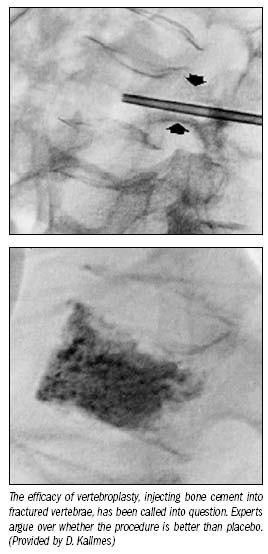Debate continues over value of vertebroplasty
Months after a pair of randomized trials published in the New England Journal of Medicine found that vertebroplasty is no better than placebo in relieving pain from vertebral fractures, a debate still rages in scientific communities.
Months after a pair of randomized trials published in the New England Journal of Medicine found that vertebroplasty is no better than placebo in relieving pain from vertebral fractures, a debate still rages in scientific communities.
Recently the Society for Interventional Radiology (SIR) declared its support for vertebroplasty for patients with painful compression fractures.
The results of two trials published in the August NEJM suggested patients receive equal amounts of modest pain relief when they are given either medical-grade bone cement injected into broken vertebrae (vertebroplasty) or a dummy injection.
The studies are discordant with personal experience and more than 15 years of accumulated medical literature espousing the benefits of vertebroplasty, said Dr. J. Kevin McGraw, section head of interventional radiology at Riverside Radiology and Interventional Associates in Columbus, OH.
“SIR recognizes the value of randomized controlled trials and evidence-based medicine. However, the weakness in the studies and the degree of discordance between the outcomes of these studies, prior studies, and experience suggest that it is premature-and possibly incorrect-to conclude that vertebroplasty is no better than a control sham procedure,” he said.

The lead author of one of the studies, Dr. David Kallmes, an interventional radiologist at the Mayo Clinic in Rochester, MN, said it's probably the case that vertebroplasty and placebo worked equally well.
“The fact that the control group got just as much better should not prompt commentators to disseminate incorrect facts about the trial's design and results,” he said.
Some of the “incorrect facts” Kallmes questions come from the Australian operator on his study, Dr. William Clark, director of interventional radiology at St. George Private Hospital in Sydney, Australia.
Patient selection in both NEJM studies was incorrect in including patients who had back pain for up to one year, Clark said.
“These fractures unite in six weeks. To inject them at six months defies logic and, of course, can only have a placebo effect,” he said in comments posted at the Arthritis Today website. “Kallmes et al excluded all inpatients from the study due to local logistics. This is the group most likely to benefit.”
Patient selection for the trial was not incorrect, Kallmes said. Fractures of less than six weeks and more than six weeks were included in the study. However, in unpublished data, a subgroup analysis found no difference between the two groups, he said.
As far as fractures uniting in six weeks, there are no data or methods to support Clark's claims, Kallmes said.
The research that promises to sway the argument on whether vertebroplasty is effective is the VERTOS II trial: percutaneous vertebroplasty versus conservative therapy in patients with painful osteoporotic vertebral compression fractures. The multicenter randomized controlled trial is led by Dr. Caroline Klazen from the radiology department at St. Elisabeth Hospital in Tilburg, the Netherlands.
The study has more than 200 subjects and includes patients with acute back pain of six weeks' duration or less.
The manuscript detailing the study results has been submitted to The Lancet for publication, according to Klazen.
A spokesperson for The Lancet said the publication date is classified information released to the author only, so it is unclear when, exactly, VERTOS II will be published.
Emerging AI Algorithm Shows Promise for Abbreviated Breast MRI in Multicenter Study
April 25th 2025An artificial intelligence algorithm for dynamic contrast-enhanced breast MRI offered a 93.9 percent AUC for breast cancer detection, and a 92.3 percent sensitivity in BI-RADS 3 cases, according to new research presented at the Society for Breast Imaging (SBI) conference.
The Reading Room Podcast: Current Perspectives on the Updated Appropriate Use Criteria for Brain PET
March 18th 2025In a new podcast, Satoshi Minoshima, M.D., Ph.D., and James Williams, Ph.D., share their insights on the recently updated appropriate use criteria for amyloid PET and tau PET in patients with mild cognitive impairment.
Can Abbreviated Breast MRI Have an Impact in Assessing Post-Neoadjuvant Chemotherapy Response?
April 24th 2025New research presented at the Society for Breast Imaging (SBI) conference suggests that abbreviated MRI is comparable to full MRI in assessing pathologic complete response to neoadjuvant chemotherapy for breast cancer.
Clarius Mobile Health Unveils Anterior Knee Feature for Handheld Ultrasound
April 23rd 2025The T-Mode Anterior Knee feature reportedly offers a combination of automated segmentation and real-time conversion of grayscale ultrasound images into color-coded visuals that bolster understanding for novice ultrasound users.